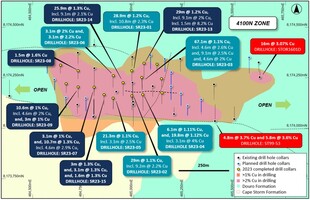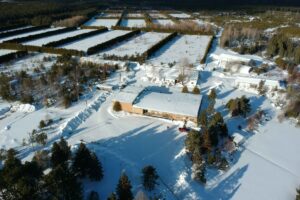American West Metals Ltd. June 22 reported assays from four additional holes drilled in 4100N Zone at Storm that cut 10- to 30-meter lenses of near-surface mineralization topping 1% copper, including a 1.5-meter subsection that averaged an amazing 8.2% copper. And the geological and geophysical evidence suggests that the high-grade copper lenses currently being drilled may be the tip of the copper iceberg at this northern Nunavut project. Following up on the success of its 2022 program, Australia-based American West launched a 10,000-meter reverse circulation drill program in April that is focused on defining a maiden Joint Ore Reserves Committee (JORC) compliant resource for three zones at Storm – 4100N, 2750N and 2200N.By May, the high-grade copper assays began rolling in from 4100N, the first target this year. Highlights from six 2023 holes previously reported include:• 15.2 meters averaging 1.2% copper from a depth of 54.9 meters; 7.6 meters averaging 1.2% copper from a depth of 79.3 meters; and 6.1 meters averaging 1.1% copper from a depth of 120.4 meters in hole SR23-01.• 29 meters averaging 1.1% copper from a depth of 59.4 meters in hole SR23-02.• 67.1 meters averaging 1.1% copper from depth of 54.9 meters in hole SR23-03.• 6.1 meters averaging 1.1% copper from a depth of 50.3 meters; and 19.8 meters averaging 1.1% copper from a depth of 77.7 meters in hole SR23-04.• 21.3 meters averaging 1% copper from a depth of 41.2 meters in hole SR23-05.• 7.6 meters averaging 1.1% copper from a depth of 53.3 meters; and 6.1 meters averaging 1.2% copper from a depth of 82.3 meters in hole SR23-06.The latest batch of assays show that four additional holes cut similar zones of high-grade copper at 4100N Zone; highlights include:• 10.7 meters averaging 1.3% copper from a depth of 76.2 meters in hole SR23-07, including a 1.5-meter subsection averaging 6.5% copper.• 10.6 meters averaging 1% copper from a depth of 67.1 meters in hole SR23-09, including a 4.6-meter subsection averaging 2% copper.• 29 meters averaging 1.2% copper from a depth of 62.5 meters in hole SR23-13, including a 1.5-meter subsection averaging 8.2% copper.• 25.9 meters averaging 1.3% copper from a depth of 61 meters in hole SR23-14, including a three-meter subsection averaging 3.7% copper.”Copper grades of 8% Cu highlight the quality of the mineralisation, and there is opportunity to expand the higher-grade zones with the mineralisation open in all directions,” said American West Metals Managing Director Dave O’Neil.Tip of the iceberg?The geological and geophysical evidence suggests that the high-grade copper lenses cut at 4100N and other nearby zones at Storm may be part of a much larger mineralized system of stacked and interconnected copper systems within a 5,000- by 2,000-meter area.American West says new drill hole data from 4100N is revealing a laterally extensive zone of mineralization that displays many of the features of a typical sediment-hosted copper deposit, including multiple stacked copper horizons. What makes this concept more compelling is a recently completed gravity survey that highlights a large and dense body underneath 4100N that is interpreted to potentially represent a larger accumulation of copper sulfides.”The continued drilling success at the 4100N Zone provides further encouragement for the potential of the recently defined and exceptional exploration targets at depth,” said O’Neil. “The largest of the geophysical targets is located directly below the 4100N Zone, and immediately adjacent to the large fault that we interpret as the main conduit for the copper mineralisation coming to surface.”American West Metals Ltd.Cross-section of the Storm project showing the copper mineralization drilled within 100 meters of surface and a potentially much larger stratiform copper target that has been identified at depth. Click on image for larger map.One deep hole drilled last year on the eastern edge of 4100N cut 68 meters of lower-grade copper, zinc, and lead mineralization that is found peripheral to higher-grade copper-mineralized core at Storm.Similar to the renowned sediment-hosted copper deposits found along the Kalahari Copper Belt in Botswana and the Central African Copper Belt in the Democratic Republic of Congo (DRC) and Zambia, the zonation at Storm appears as a large copper-rich core (chalcocite, bornite and covellite) that gives way laterally and vertically to thinner peripheral zones of copper-iron (chalcopyrite), iron (pyrite), zinc (sphalerite) and minor lead (galena). American West says the recognition of this zonation provides a powerful vector for exploration as the company continues to drill 4100N before moving on to 2200N and 2750N, where one hole drilled last year, ST22-05, cut 41 meters averaging 4.18% copper from a depth of 38 meters.”We look forward to providing further updates on drilling and other exploration activities in the coming weeks,” said O’Neil.Author Bio
Shane Lasley, Publisher
Over his more than 15 years of covering mining and mineral exploration, Shane has become renowned for his ability to report on the sector in a way that is technically sound enough to inform industry insiders while being easy to understand by a wider audience.
Email: [email protected] Phone: (907) 726-1095
This article was published by:
Visit the original article here



